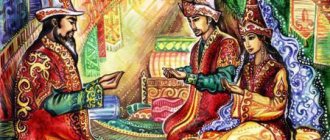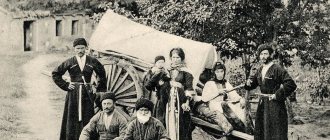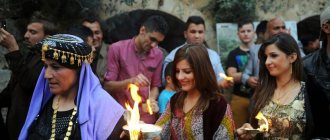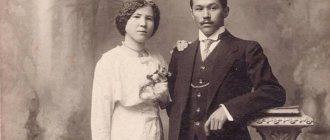A Dagestan wedding is a beautiful celebration that is celebrated for several days on a grand scale. The holiday is accompanied by national customs and traditions that are unlike those of other nations.
To attend a Dagestan wedding means to see the entire culture of the people. After all, at a wedding they not only observe customs, but also make national toasts, dance Dagestan dances, and put on folk costumes.
What is it like - a beautiful Dagestan wedding?
Features of the national celebration
Dagestan weddings are difficult to confuse with any others. And all thanks to national characteristics.
- A traditional Dagestan wedding is celebrated for two days. But exactly 7 more days pass between them.
- There are a huge number of guests at the wedding - from 300 to 1500. These are necessarily close and distant relatives, friends, colleagues. People who are not officially invited can also come to the celebration: neighbors, acquaintances, or simply residents of a city or village. The last ones do not have to stay at the holiday, but they are obliged to congratulate the newlyweds and make a toast.
- At the request of the parents and newlyweds, the wedding can be held in one of two options: a religious Muslim one without alcohol, loud music and dancing, or a classic one with alcohol, a lush table, and noisy festivities.
- Parents begin collecting money for a wedding from the birth of their child. Guests give a lot of money for the future wedding, for the bride's dowry, for ransom. This fact leads to the fact that money for organizing a wedding goes without an account.
- A national feature, which is now rarely observed, was that the parents themselves chose the groom for the bride. The newlyweds got to know each other right at the wedding. Nowadays this custom is observed extremely rarely.
- In the past, bride kidnapping was a very common practice. It was a beautiful national custom. Now they resort to it when the parents of the bride and groom do not give their blessing for the marriage. When the groom steals his beloved, he brings her to his house. And an unmarried girl who spends the night in a man’s house is considered disgraced. And, in order to wash away this shame from the family, the parents have no choice but to agree to the wedding.
- The wedding date should not fall on the newlyweds' birthdays, parents' birthdays, or Muslim religious holidays.
Wedding ceremonies of the peoples of Dagestan
Bibliographic description:
Ismailova, A. M. Wedding rituals of the peoples of Dagestan / A. M. Ismailova.
— Text: immediate // History and archeology: materials of the I International. scientific conf. (St. Petersburg, November 2012). - St. Petersburg: Renome, 2012. - pp. 80-83. — URL: https://moluch.ru/conf/hist/archive/61/2723/ (access date: 02/16/2021). Dagestan is one of the most unique regions in terms of the ethnocultural diversity of the population living here. Similar natural-geographical and historical-social conditions contributed to the development of both a national culture among the various ethnic populations of Dagestan and the distinctive features inherent in a particular people.
This was most clearly manifested in the rituals of the life cycle. And one of the important rituals is the wedding, where one can highlight the features of national and local identity. A wedding is a big holiday in a Dagestan village, which was always held solemnly, with all village residents participating in it. A wedding in every urban village was a set of ritual actions designed to ensure a long and happy married life for a young couple, to provide them with numerous offspring, as well as this great festive celebration for the entire population, a colorful spectacle, a kind of performance with a well-known scenario, where the main characters the faces knew their roles perfectly. The director—the manager of the entire action, where each spectator was also a performer—was a specially appointed presenter, who was called differently among different peoples of Dagestan, and sometimes in different villages of the same people: shah, toastmaster, etc.
The peoples of Dagestan had several forms of marriage. The most common one among them all was arranged marriage. The ritual that formalized it began with matchmaking, during which the parties agreed on the size of the bride price and the timing of its payment, according to Kaloev, “the bride price has great symbolic meaning in Dagestan and can easily be omitted”[1;C131]. Some nationalities of Dagestan require the groom to pay a marriage gift, while others exempt him from this obligation. The first include the Avars and some peoples of southern Dagestan, the second - the Dargins and Laks. But if the bride price gradually disappeared, the same cannot be said about another type of payment, known as kalym. The adats of southern Dagestan society tell us about the existence of marriage payments. “Any man who wants to marry a girl or widow must pay a conditional payment for her to her relatives, and for not their estate to their guardian” [2;C19]. The Koran determines that the ransom must belong to the wife, as a kind of material guarantee in case of divorce. Sharia also ascribes the receipt of a ransom by the bride's parents. The payment of bride price for the bride was as important an attribute of marriage as its registration with the mullah. “Only a Muslim nikah formalized by a servant of Allah in accordance with all the canons of Sharia is considered a legal marriage. This was unshakable among all the peoples of the North Caucasus, for whom Islam was the official religion” [3;C102]. It should be noted that bride price took place among all Dagestan peoples, but the size was not the same, and its value largely depended on the customs accepted in a given particular society, on the economic well-being of the society, financial situation, and class affiliation.
Arranged marriage fell into two types: conspiracy of minors and conspiracy of adults. “Very common,” wrote S.Sh. Gadzhieva, - the custom of conspiring with children, even soon after birth; in this case, the boy’s father usually gives, as a deposit, some thing to the girl’s father, and from that time the minors are already considered the bride and groom”[2;C19]. Lullaby betrothal (less common than other variants of such a conspiracy) was widely known among Lezgins [5;C41]. “Prosperous people prepare grooms and brides for their children when they are still in infancy”[6;C17]. Yet the most common form of conspiracy was conspiracy among adults. In this arrangement the traditional ceremonies were most fully observed; 1) matchmaking and presenting a gift to the bride; 2) engagement; 3) home visit; 4) sending the bride to the groom's house.
The peoples of Dagestan have always attached great importance to the marriage of a son or the marriage of a daughter. Choosing a bride or groom was considered a serious and responsible matter. It was practiced not only by the family, but also by a wider circle of relatives, and even by the tukhum as a whole. When assessing the personal qualities of the bride, first of all, her hard work, restraint in showing emotions, and knowledge of the rules of etiquette were taken into account. In addition, it was required that the girl be physically strong, capable of having healthy offspring and performing numerous duties around the house, home and raising children. “The main thing that is valued in a bride is her origin and her ability to do housework” [8;C143].
Among the Dargins and Laks, the first visit to the girl’s house was made by the boy’s parents. The influence of matchmakers was significant. Another custom was widespread among the Avars: for negotiations, the young man’s family invited the girl’s father, generously treated him and made an offer. As a rule, the matter was not limited to one visit. “A good girl will not agree to get married until the matchmakers’ shoes wear out”[9;C173].
There were cases when the issue of marriage was decided immediately, and the boy’s mother immediately put silver rings and a bracelet on the girl. But this happened very rarely. Matchmaking was fundamentally different from all other “actions” of the wedding ceremony in that it remained a secret and was always carried out in the narrowest circle. The next stage was engagement. At this stage, the groom's ambassadors went to the bride's house with gifts, in some places they were accompanied by all the relatives. Of course, for each nation and in each locality the quantity and value of the gift was different. Among the Avars, the groom's gifts and the bride's dowry were often hung on ropes in the bride's yard for public viewing and appreciation.
A mandatory condition for marriage was the performance of a religious marriage ceremony - “mah'ar”, “magar” (among the Avars, Laks, Dargins), “nikah” among the Lezgins, “kebin” among the Azerbaijanis. The ceremony was performed either in the groom's house, or in the house where he went during the wedding, or at his mother's. Usually the ceremony took place with the participation of the groom and the father of the bride. The ceremony was performed on the eve or on the wedding day. The bride had to obtain permission to marry from her father - furman, and in the event of her father's death - from another relative (guardian). The girl herself did not participate in the ceremony, but the groom sometimes did. It was a common custom among the Laks that “maghar” was performed in front of the confidant of the bride and groom. The Avars had a slightly different ritual. As Przhetslavsky noted, among the Avars, “marital unions were concluded either verbally in front of witnesses, or by an attorney from the groom or his parents.” The entire ceremony of the marriage transaction of the assembled parents of the bride and groom included an announcement of their desire to give away, and the latter - their agreement to accept the bride chosen by the groom”[10;C160]. The main cycles of the ritual were strictly regulated by the basic laws of Sharia, as well as adats. One of the proofs that marriages were concluded in Dagestan mainly according to Sharia law was the religious role of the father in giving the bride away. “Only the father has the right,” says the adats of the Samur district, “to marry off his daughter against her wishes, but other relatives and guardians do not have this right, so that a girl betrothed during her father’s life can, after his death, refuse to marry the same groom, to whom she was engaged.”[11;P.2]. Neither young men, nor especially girls, were free in their marriage choice. The final say belonged to their parents, who also had to reckon with numerous traditional rules for marriage. The central focus of the wedding celebration was the bride's move from her father's house to the groom's house. Among the Laks, on the day of transfer of the bride from her father's house to the groom's house, or on the evening preceding this, several women from her went to the young man's house and performed the ritual of curtaining the corner of the room intended for the young. This was where their wedding bed was supposed to be. Among the Dargins, on the night before the bride was transferred to the groom's house, a huge pie was baked in her house and halva was made. Among the Laks, after dancing in the bride's house in the evening of that day, which was attended by the bride and her friends, she stayed all night and spent time playing and dancing. Among the Dargins and Avars, on the day the bride was transferred to the groom, all the male relatives of the bride were invited to his house. Before leaving for the groom's house, the girlfriends dressed the bride in the best clothes given by the groom. The groom himself never followed the bride. Each people and ethnic group had their own rituals, an established system of actions, performed by representatives of both sides at a certain point in the wedding cycle. Among the Dargins, the bride was first met by the groom's father, who took two or three steps with her towards the entrance to the house. Upon entering the groom's house, the bride had to perform a ritual of refreshments. Different peoples performed the ritual differently. Among the Dargins, the bride was treated to honey and also sprinkled with sweets. This ritual was performed by a mother or an elderly relative. Among the Lezgins, when entering the groom's house, the bride had to crush with her right foot a spoon with butter placed on the threshold. After this, the bride was brought into the room and seated on a chest with her dowry. In the group of described rituals associated with bringing the bride to the groom's house, the purpose of which was considered to ensure her a happy life in the new home, great importance was attached to showering her with flour, rice, and sweets. Small silver coins were thrown at the bride's feet. Among customs and rituals, a special place was occupied by those that were supposedly aimed at ensuring the dominance of a husband over his wife or, conversely, a wife over her husband. When entering the groom's house, the lad tried to touch the lintel above the door. Usually the groom's relatives placed the bride in the corner of the room, behind a screen. The role of the groom at this time was different among different peoples. For some, he did not participate in the celebration at all, he waited until the guests left. According to old mountain etiquette, the groom has no right to be at his own wedding. The groom is driven out of sight to the neighbors, or better yet, into the attic, so that at least from there he can see his own wedding. His friends bring him food from their own table, secretly, of course, but so that the wedding party notices and appreciates it. Others (Dargins), on the contrary, participated. The bride, isolated behind a curtain, did not take part in the feast at all. The day after the wedding night, the wedding took place in the groom's house. In the morning, women gathered at the bride’s place to eat ritual porridge (laksi), and the groom went to the river. Among the Dargins, a friend brought meat dumplings from her parents' house, prepared by the bride's mother. Among the Avars, the wedding itself was generally held on the second day. On the same day, the newlywed was presented with gifts from her husband's relatives. Among some Avars and Dargins, it was customary on the second day to invite the parents and other close relatives of the bride to the groom’s house for refreshments. This day, as a rule, ended among all nations with a dance of the newlyweds, and any of the men present at the wedding could dance with the bride. During this dance, it was customary for the Dargins to present the bride with a small amount of money. Most often, on the third day of the wedding, it was customary to invite the newlyweds to her parents’ house. After the wedding, the young woman was symbolically introduced to work and invited to her parents’ house. All wedding cycles were full of rituals, but actions aimed at causing laughter were concentrated mainly in the rituals of the wedding itself. A jester dressed up at a wedding in the 19th - early 20th centuries. - This is a purely funny character, the organizers of the wedding were just as worried about ensuring the presence of whom at the wedding as they were about ensuring that there was music and refreshments. It should be noted that the manifestation of this laughter culture manifested itself differently in each nation. So, for example, in a Rutul wedding, mummers in women's clothing portrayed pregnant women, and also in a parody form imitated the performance of various women's jobs (carding wool, spinning, etc.).
In the Avar village Kikuni mummers began their participation on the wedding day, preceding the transfer of the bride to the groom's house. In the evening of this day, they appeared at the bride's house, portraying the bride and groom, accompanied by the groom's friends, with music. Sometimes the groom could appear here under the guise of one of the mummers. A significant role was played by the mummers at the Agul wedding, where their actions related to the first three days of the wedding, before the bride was brought into the groom’s house; these were young people from the village. The mummers staged a mock fight among themselves. They showered those present with oatmeal and flour, ridiculed and humorously punished the “troublemakers.”
Having examined all the above material, it is not difficult to notice that both national features characteristic of all peoples and local specifics of individual ethnic groups are clearly distinguished. The diversity and wide range of features of ethnocultural phenomena shows that many manifestations and phenomena of the culture of the Dagestan peoples, perceived as nationally specific, special, are essentially variants of the local manifestation of more general models that have a general Dagestan, often all-Caucasian character.
Literature:
- Kaloev B.A. MM. Kovalevsky and his studies of mountain peoples. M., 1979.
- Collection of information about the Caucasian highlanders. Tiflis, Vol. 3. 1870.
- Avksentyev A.V. Islam in the North Caucasus. Stavropol. 1984.
- Gadzhieva S.III. Family and marriage among the peoples of Dagestan in the 19th - early 20th centuries. M., 1985.
- Gadzhieva M.I., Omarov A.O. Family of peoples of Dagestan in historical development. Part 1. Makhachkala, 2000.
- Collection of information about the Caucasian highlanders.
- Israpilova Z.A. Marriage and family rituals of the Andal Avars. Makhachkala 2002.
- Gadzhieva S.III. Op. op.
- Peoples of Dagestan. M., 2002.
- Przhetslavsky P. Decree. op.
- Kaloev B.A. Decree. op.
- RUK. fund. IIAE DNTsRAN F.5 He. 1. P. 23.
How does matchmaking work?
The customs of a Dagestan wedding begin with matchmaking. It is also called collusion. This is the procedure for concluding an agreement and discussing all the nuances. Representatives of the groom: parents, relatives, friends come to the house of the future wife, look at the well-being of the family, inquire about the bride's dowry, and discuss the size of the bride price. There is no fixed size in this matter.
Matchmaking can be carried out in two ways:
- The agreement between the parents is concluded when the bride and groom are still children. Such a conspiracy is called a “lullaby”. During this ceremony, the opinions and wishes of the bride and groom are not asked. If all the conventions were discussed, the father of the bride gave the father of the groom a valuable thing, which served as a symbol of the conclusion of the contract, and from now on the children became the bride and groom. More often such collusion can be found among the Lezgins.
- The conspiracy takes place when the potential bride and groom are already adults. This look is relevant for a modern Dagestan wedding. The bride is given valuable gifts, which in some regions, along with her dowry, are hung on ropes near the house, showing them off to others. If everyone is satisfied with everything, then the engagement takes place. Afterwards, the groom and parents visit the bride's house, and then a return visit is held.
Matchmaking traditions
Dagestanis are famous for their eccentricity, which is why bride kidnapping has been popular in this country for a long time. Bride kidnapping at a wedding in Dagestan still happens, but more often in cases where parents forbid the newlyweds to get married. Brides are also stolen when young people are from different classes. It was considered disastrous for a girl to spend the night in a man’s house, so parents most often agreed to such blackmail in order to protect their daughter from shame.
Often a wedding occurs after an agreement or matchmaking. Matchmaking in Dagestan includes a visit of the groom's representatives to the bride's house. On this day, they agreed on the size of the bride price and inquired about the dowry of the young bride. Payment for the bride was mandatory in all regions of the country, but the amount was not specified.
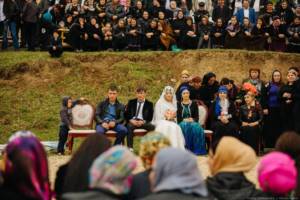
Matchmaking in Dagestan had two varieties. In the first case, small children were bound by wedding obligations. This type was called “lullaby matchmaking,” when, without the decision of the future bride and groom, they agreed on their marriage. The girl's father gave the boy's father a valuable item as collateral, after which the children were considered the bride and groom. This type of conspiracy is most characteristic of the Lezgins. Dagestan matchmaking among adults is more widespread, especially in the modern world. This type of conspiracy is filled with national traditions, which include several stages. First, matchmaking takes place, during which the bride is presented with gifts. In some regions, all these gifts, along with the dowry, were hung on a rope by the girls so that everyone could contemplate them. Then the pre-wedding engagement of the Dagestani newlyweds takes place, followed by the groom's visit to the bride's house and her visit to the groom's house.
In Dagestan, matchmaking is very different from all other wedding customs. It happens secretly, in the evening and among close relatives.
Wedding preparations
You can celebrate the occasion in the restaurant hall, banquet hall, or at home. The main thing is that the room is spacious enough, since the number of guests varies from several hundred to two thousand. Such a scale involves spending huge sums of money.
They start collecting money from the birth of children, but the actual preparation for the celebration begins after the engagement. Both the bride and the groom begin to prepare. The first day of the holiday is spent with the bride, the second - with the groom. If living conditions do not allow hosting a huge number of guests, then it is possible to hold the event in a restaurant.
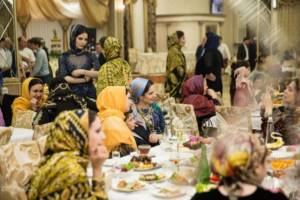
Official registration takes place only on the second day. By the way, extending the wedding over two days is associated with national custom: parents do not have the right to attend such an event with their daughter, since she came under the protection of the groom’s family. The bride went to the groom's house accompanied by her unmarried sisters.
But the parents wanted to see their daughter’s wedding, and the bride herself wanted her parents not to stay away from the important day in her life. In order not to offend anyone, but also not to go against custom, mini-weddings began to be held in the bride’s house. In modern Dagestan, gatherings in the bride's house have become a full-fledged wedding day, which is celebrated on a grand scale.
After the engagement, the preparations are mainly carried out by the parents of the newlyweds. But the bride also does not stand aside. Her responsibilities include preparing the future family “nest”: choosing furniture, arranging it in the house, and decorating the interior.
Dagestan customs at a wedding

A wedding in Dagestan is distinguished by its “scope”. A huge number of guests, noise, music, fun, many different treats. In Dagestan, two weddings are traditionally celebrated. The first wedding takes place in the bride's house, and the second wedding is celebrated in the groom's house. The total number of guests at a wedding celebration, as a rule, can reach one and a half thousand people.
Preparing for a wedding in Dagestan

An important point when holding this celebration in Dagestan is the observance of all national rites and rituals. According to Dagestan customs, preparations for the wedding day begin almost immediately after the birth of the child. Parents already then begin to collect a dowry and accumulate funds for a future wedding. That is why, several years later, a truly luxurious celebration is organized for the newlyweds.
Pre-wedding engagement of Dagestani newlyweds

Among the Dagestanis, like any other people, the procedure for declaring a young bride and groom is called engagement, or betrothal. Matchmakers are sent to the bride's house, where the matchmaking ceremony takes place, where she is presented with various gifts. Here the parents of the bride and groom set a wedding day, which should not coincide with the birthdays of the newlyweds or their parents, Muslim holidays, and also should not be during Uraza.
A Dagestan wedding does not take place without the official registration of the newlyweds at the registry office. At the end of the engagement ceremony, they go to the registry office and submit an application for their desire to get married. According to Dagestan customs, the bride and groom can meet only occasionally before the wedding and in no case should they spend the night together. Next begins preparations for the celebration itself. This is the choice of wedding dresses, the location of the wedding itself, the choice of restaurant and menu, inviting guests, decorating the hall, various organizational issues, and so on.
Dresses for the celebration
In a modern Dagestan wedding, brides are not limited in their choice of dress. The only condition is that it must be long, graceful, expensive and sophisticated: made from expensive fabrics with the addition of expensive jewelry. No scarf or veil is used.
However, no one forgets about the traditional decoration of the bride. It is being prepared as a second outfit for a wedding.
For the groom, everything is much simpler with his outfit - any classic suit. But if you do not deviate from traditions, then the groom must have a second wedding suit in which he will perform a formal dance. The main attribute of this costume is the hat.
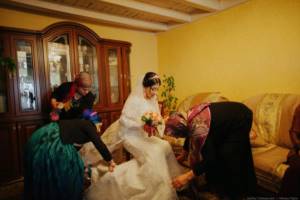
Wedding: day one
Holding the holiday over two days is also explained by the fact that, as a rule, a Dagestan wedding is celebrated only once. Divorce is an extremely rare phenomenon among the Dagestan people. The strength of the union is connected with the religiosity of the people.
The first day of the wedding - in the bride's house - begins with the performance of ritual music. Invited musicians sit on the roof of the bride's house and perform folk songs reminiscent of a prayer motif.
At this time, the bride is actively preparing for a Dagestan wedding in the house. At 12 o'clock in the afternoon, a festive procession leaves the groom's house, consisting only of women - the groom's relatives. The groom himself and his entourage follow the procession, performing songs characteristic of a Dagestan wedding. Those walking with them carry gifts in the form of sweets, jewelry and carpets. As soon as the guests enter the bride’s house, all the brought treats and gifts are put into a chest, which the bride will take with her to her now home.
The bride's mother, accompanied by other female relatives, hands over her daughter to the groom's family. The whole process is accompanied by crying and lamentations, which are used to mourn the daughter’s departure from her parents’ home. Although that night the bride still remains in her parents' house.

TRADITIONS OF MOUNTAIN DAGESTAN WEDDING
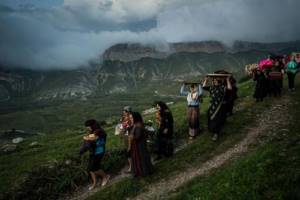
Local residents say that traditions are dying and it is now customary to celebrate a wedding in the city. They invite several hundred guests and party to the fullest. And even if a wedding is celebrated in a village, they no longer try to follow all the rules as they did before, even before cars and electricity appeared. But somewhere the stars aligned, so much so that during my trip through the mountains, a wedding was celebrated here exactly as it was before. Therefore, instead of a well-deserved rest in Makhachkala, I spent the last two days in the mountain village of Balkhar. I liked everything, but I would add the number of torches, while I followed the procession through the narrow streets between the houses, I almost broke my legs on the stones, which were probably specially thrown there so that people like me wouldn’t walk.
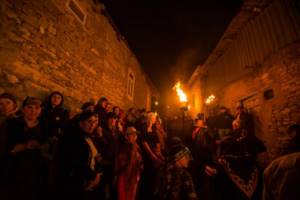
Weddings used to last for three days; in some places they still celebrate in full, starting to taste cognac in the morning, while others reduce it to two. Not the point. I came to the most interesting events, which begin just in the evening. The village has a gorgeous clearing at the very top of the village. I can’t think of a better place to celebrate; there are gorgeous views of the meadows, mountains and sky all around. I would celebrate my wedding here too.
Next door to us.
A line of women carries the dowry for the bride (to the groom's house). Nowadays, the dowry is often transported by car, but it does not look so beautiful and aesthetically pleasing.
They carry all sorts of carpets, blankets, jugs, caskets, in short, everything that can be useful in the household. Of course, there are jewelry and money.
Everything brought is stored in the newlyweds’ room. And now everyone is waiting for the most important thing to begin. And the most important thing is a procession through the village at night with torches (not because it is necessary to light the road, but because this is how they used to do it) from the groom’s house to the bride.
We had to wait two hours. To somehow kill time, everyone gathered in the backyard, and dancing began to the music of the visiting musicians.
But the torchbearers began to fuss, which means the parade will soon take place. Several torches were taken out of the house. A torch is a tin can with dung inside (does everyone know what dung is?) generously sprinkled with kerosene. All this is set on fire and voila, you can start!
Trying not to fall, I followed the crowd of joyful men who accompanied the groom with shouts and whistles. Looking at the ceremony, I couldn’t help but feel like I was in the Middle Ages. I recommend everyone who wants to experience something like this to visit these lands while such traditions are still alive.
The bride's house appeared. Thank God, it was a short walk through the dark streets.
We were greeted as heroes. Near the entrance to the house, probably the whole village had gathered, there was no crowd.
Then everything is simple, boys to the right, girls to the left. The girls gather in the room where the bride is sitting, and the guys gather at the table. Cheers and toasts were made from around the table every now and then, but the most interesting thing happened with the girls. They dressed up the bride.
As a result, the bride is covered with her head and now she will move only with the help of two friends who are always with her.
A special lamp was brought into the room for the bridesmaids to light the way.
And below, in the courtyard of the house, there was smoke like a rocker.
Everyone is waiting for the procession to begin. And as usual, the wait drags on. I don’t know, maybe this is how it should be, but in general, the bride is in no hurry.
We waited, the girls finally came out. From behind, someone started throwing candy and at the bottom of the procession there was another stampede, this time of boys collecting candy. At that moment, from the street I saw strong reflections, at first I thought that the neighbors had started a fire, but no. They began to make fires.
The bonfires are lit by the residents of the houses the bride passes by. And they divorce if they have good relations with the house of the groom and daughter-in-law, and the fire means a wish for well-being. This is me briefly describing the essence. If the fire is not lit, this means that there are serious disagreements between houses/families.
A huge crowd formed behind the bride. The crush was such that I didn’t risk being in the thick of it, the guys were pushing each other, and this is probably also part of the ritual.
The procession reached the groom's house, where the bride was brought in. There she must pass another test, roll bread into the room. I didn’t try to get there and film this process.
The next day, after a long and stormy night, the residents gather again. About two o'clock, not earlier. People are slowly flocking to the clearing, and a line of relatives with food and drink flows from the house of the bride and groom.
Again the grandmothers come forward and one with a tambourine. They sing and lead the bride to the people. She's in a new outfit, but her best friends are still with her.
Probably the whole village is gathering in the clearing. During the entire time the people are having fun, dancing and making toasts, the bride dances three dances.
The rest of the time, music plays non-stop and someone is in the center of the circle.
Wedding: day two
The second day takes place at the groom's house. He comes to his wife's house and takes her under his wing. But before picking up the bride, the groom is greeted by her sister, performing a national celebratory dance before the wedding. Afterwards, the girl’s mother gives the newlyweds a cup of honey to drink. This is a symbol of a happy family life.
It is on the second day that many noisy and fun events take place. Shooting in the air, songs and dances, competitions for guests. On the second day of a Dagestan wedding, Lezginka is the most popular favorite entertainment.
The celebration begins after 12 noon, when the groom brings the bride into the house. The holiday is accompanied by dancing, with men dancing separately from women.
The newlyweds also perform their first dance. But this event is preceded by another custom: the bride must dance with every man present at the wedding. But the dance looks like this: a girl dances, and a man spins around her, throwing money near her.
The entire wedding event is conducted by a toastmaster - a pre-selected relative. He holds competitions, makes toasts, and monitors the observance of traditions.
Engagement
Like most peoples, a wedding is preceded by an engagement. Matchmakers are sent to the girl’s house and they present the family with gifts. Having gathered for a council, the parents of the young people set a date for the marriage, which should not take place on the birthday of the young people, and also their fathers and mothers, and most importantly, not on holidays celebrated by Muslims. The engagement takes place secretly in the evening in a close circle of relatives. Having agreed on a date, the guy and girl go to the registry office to submit an application, and from this date active preparations for the wedding begin: clothes for the newlyweds are chosen, a menu of treats is agreed upon, and a convenient room in the restaurant is selected.
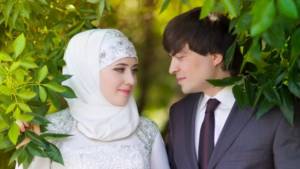
According to folk customs, the first day of the wedding is celebrated in the house of the future wife, where, according to custom, female guests gather. The girl’s friends sing sad songs, seeing her off to her new life, and the girl says goodbye to her parents’ house. Then they meet the groom with a large retinue and gifts: beautiful carpets and luxurious gold jewelry. Everyone sings funny songs and presents gifts, which are placed in a chest for the newlyweds.
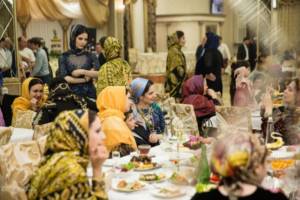
The second day of the celebration begins to be celebrated in the groom's house, a week after the celebration in the bride's house. The second day of the celebration begins with the guy’s father arriving at the bride’s house, taking a candle and a mirror, since these attributes should bring the newlyweds a prosperous and happy life. The bride puts on her colorful outfit, which, due to the large amount of jewelry, is recognized as one of the most expensive in the world.
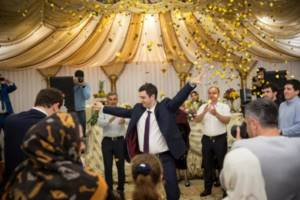
Previously, the bride's hair was tightly covered with a scarf, but now a scarf on her head is rarely seen. Nowadays girls prefer fashionable hairstyles with intricate weaves, which are the masterful work of a hairdresser.
The bride's friends, covering the girl's face with a special cape, take her out into the yard, and then the girl with the groom's father and his retinue go to their house. The entire path to a new home is accompanied by traditional folk singing and cheerful music on folk instruments. Often this procession is stopped by acquaintances or strangers, blocking the road, and demanding gifts. At the door of the house, the groom and the girl are greeted with honey so that the life of the spouses is sweet and rich.
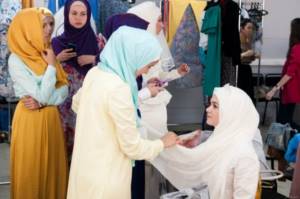
An interesting custom at a Dagestan wedding is loud shooting, which is organized by the groom’s friends in order to drive away negative energy from the house and so that there is only a happy life in the house.
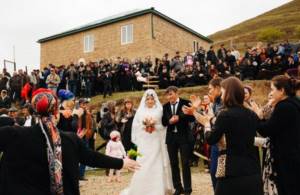
An interesting fact is that women and men sit separately from each other at the wedding feast. There are many national dishes on the tables. At a wedding, one of the main events is the dance of the newlyweds. Before this dance, the bride dances with the men who came with her friends. For guests at the celebration, the most favorite entertainment is the Lezginka dance.
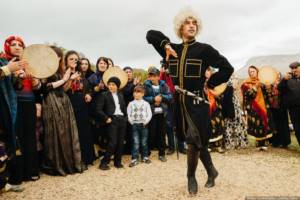
We told you how interesting and fun a Dagestan wedding can be. Such a grand celebration will give a billion positive emotions and impressions not only to the newlyweds, but also to all the guests present!
Comments (0)
Modern wedding in Dagestan
Modern Dagestani weddings are increasingly reminiscent of European celebrations. Some customs have become obsolete, while others continue to be observed.
- The groom must dance Lezginka, dressed in national costume.
- National treats are always present on the tables: shish kebab, khinkali, dolma, pilaf, etc.
- The bride's dowry and bride price from the groom must be collected.
- The groom always comes for the bride at the head of the solemn procession.
At Dagestan weddings, they already hire a toastmaster - a professional host, not a relative. More often, restaurants and banquet halls are rented for events, which are decorated in a modern way. Popular music is playing.
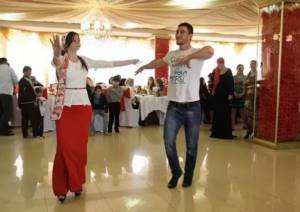
The entry of the bride into the groom's house: a national custom
This beautiful custom - the bride's entry into the house of her future husband - was previously preceded by repeated visits of the bride and groom's relatives to each other several weeks before the wedding. Nowadays this is done only after marriage.
The bride's entry into her husband's house is accompanied by showering her with nuts, coins and sweets, as a symbol of the fact that in this house the girl will not know either grief or need. In some regions of Dagestan, the bride is sprinkled with flour.
As soon as the bride crossed the threshold, the groom's mother handed her a cup of honey, which the bride had to drink.
After the wedding was over, the mentor (now the wife) told her how to spend her wedding night: how to behave and what to do. The young husband begins to fulfill his marital duty only after he asks the girl about her true desire to become his wife and receives a positive answer.
National dances
At a Dagestan wedding, the Lezginka is a mandatory, traditional dance that everyone loves and knows how to perform: both men and women. It is in this dance that the full character and potential of the Dagestanis is revealed. They put their “soul” into this dance.
In general, at a Dagestan wedding, the dancing is opened by the aravul, the main dancer at the celebration. The beginning of the dances he puts in place is called “dem”. Afterwards, male guests join the dancer.
At the beginning of the dance, men are given flowers - a symbol of invitation to dance. As soon as a man feels tired, he can give flowers to another, who has no right to refuse the invitation. Such dance events last until the end of the holiday.
Dancing at a Dagestan wedding for girls and women begins with an invitation from the groom’s sister. It is she who has the right to be the first to start dancing. Women can also dance Lezginka at a Dagestan wedding.
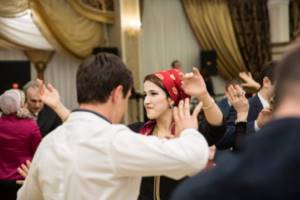
Is it possible for Dagestanis to marry other peoples?
The Russian-Dagestan wedding takes place in modern times, despite the difference between these two peoples.
Preparing such a wedding is, first of all, a discussion between the two parties (bride and groom) of all the nuances relating to the observance of Russian and Dagestan traditions. What is acceptable at a Russian wedding and not accepted at a Dagestan one, and vice versa.
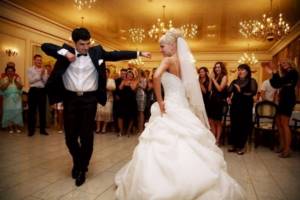
Many couples compromise and hold only the most interesting customs and competitions characteristic of each nation at their celebration.


